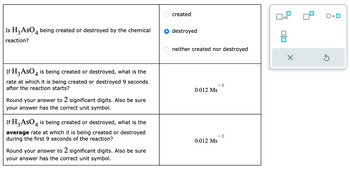Here is a graph of the molarity of arsenic acid (H₂AsO4) in a reaction vessel during a certain chemical reaction. Use this graph to answer the questions in the table below. M 0.30- 0.269 0.25- 0.20 0.15- 0.10- 0.05- y 0 10 15 seconds Is H3 ASO4 being created or destroyed by the chemical reaction? If H3 AsO 4 is being created or destroyed, what is the rate at which it is being created or destroyed 9 seconds after the reaction starts? 20 25 created Odestroyed 30 X Oneither created nor destroyed 3 x10 00 8 X 0.0 Ś
Here is a graph of the molarity of arsenic acid (H₂AsO4) in a reaction vessel during a certain chemical reaction. Use this graph to answer the questions in the table below. M 0.30- 0.269 0.25- 0.20 0.15- 0.10- 0.05- y 0 10 15 seconds Is H3 ASO4 being created or destroyed by the chemical reaction? If H3 AsO 4 is being created or destroyed, what is the rate at which it is being created or destroyed 9 seconds after the reaction starts? 20 25 created Odestroyed 30 X Oneither created nor destroyed 3 x10 00 8 X 0.0 Ś
Chemistry
10th Edition
ISBN:9781305957404
Author:Steven S. Zumdahl, Susan A. Zumdahl, Donald J. DeCoste
Publisher:Steven S. Zumdahl, Susan A. Zumdahl, Donald J. DeCoste
Chapter1: Chemical Foundations
Section: Chapter Questions
Problem 1RQ: Define and explain the differences between the following terms. a. law and theory b. theory and...
Related questions
Question
Please take your time and answer them correctly, thank you.

Transcribed Image Text:Is H3 AsO 4 being created or destroyed by the chemical
reaction?
If H3 AsO 4 is being created or destroyed, what is the
rate at which it is being created or destroyed 9 seconds
after the reaction starts?
Round your answer to 2 significant digits. Also be sure
your answer has the correct unit symbol.
If H3 AsO 4 is being created or destroyed, what is the
average rate at which it is being created or destroyed
during the first 9 seconds of the reaction?
Round your answer to 2 significant digits. Also be sure
your answer has the correct unit symbol.
created
destroyed
neither created nor destroyed
0
x10
010
X
5

Transcribed Image Text:Here is a graph of the molarity of arsenic acid (H₂AsO4) in a reaction vessel during a certain chemical reaction. Use this graph to answer the questions in the
table below.
3
0.30
0.269
0.25-
0.20
0.15
0.10-
0.05
0
y
5
10
15
seconds
Is H3 AsO 4 being created or destroyed by the chemical
reaction?
If H3 AsO 4 is being created or destroyed, what is the
rate at which it is being created or destroyed 9 seconds
after the reaction starts?
20
O
25
created
destroyed
30
neither created nor destroyed
0
x10
00
X
Ś
Expert Solution
This question has been solved!
Explore an expertly crafted, step-by-step solution for a thorough understanding of key concepts.
This is a popular solution!
Trending now
This is a popular solution!
Step by step
Solved in 3 steps with 3 images

Follow-up Questions
Read through expert solutions to related follow-up questions below.
Follow-up Question

Transcribed Image Text:Try Again
Your answer is incorrect.
• Row 2: Your units are wrong.
•
Row 3: Your units are wrong.
Here is a graph of the molarity of arsenic acid (H₂AsO4) in a reaction vessel during a certain chemical reaction. Use this graph to answer the questions in the
table below.
M
0.30-
0.269
0.25-
0.20
0.15-
0.10-
0.05
0
y
10
15
seconds
20
25
30
X
S

Transcribed Image Text:Is H3 AsO 4 being created or destroyed by the chemical
reaction?
If H3 AsO 4 is being created or destroyed, what is the
rate at which it is being created or destroyed 9 seconds
after the reaction starts?
Round your answer to 2 significant digits. Also be sure
your answer has the correct unit symbol.
If H3 AsO 4 is being created or destroyed, what is the
average rate at which it is being created or destroyed
during the first 9 seconds of the reaction?
Round your answer to 2 significant digits. Also be sure
your answer has the correct unit symbol.
created
destroyed
neither created nor destroyed
0.012 Ms
0.012 Ms
1
- 1
x10
0|0
X
Ś
Solution
Knowledge Booster
Learn more about
Need a deep-dive on the concept behind this application? Look no further. Learn more about this topic, chemistry and related others by exploring similar questions and additional content below.Recommended textbooks for you

Chemistry
Chemistry
ISBN:
9781305957404
Author:
Steven S. Zumdahl, Susan A. Zumdahl, Donald J. DeCoste
Publisher:
Cengage Learning

Chemistry
Chemistry
ISBN:
9781259911156
Author:
Raymond Chang Dr., Jason Overby Professor
Publisher:
McGraw-Hill Education

Principles of Instrumental Analysis
Chemistry
ISBN:
9781305577213
Author:
Douglas A. Skoog, F. James Holler, Stanley R. Crouch
Publisher:
Cengage Learning

Chemistry
Chemistry
ISBN:
9781305957404
Author:
Steven S. Zumdahl, Susan A. Zumdahl, Donald J. DeCoste
Publisher:
Cengage Learning

Chemistry
Chemistry
ISBN:
9781259911156
Author:
Raymond Chang Dr., Jason Overby Professor
Publisher:
McGraw-Hill Education

Principles of Instrumental Analysis
Chemistry
ISBN:
9781305577213
Author:
Douglas A. Skoog, F. James Holler, Stanley R. Crouch
Publisher:
Cengage Learning

Organic Chemistry
Chemistry
ISBN:
9780078021558
Author:
Janice Gorzynski Smith Dr.
Publisher:
McGraw-Hill Education

Chemistry: Principles and Reactions
Chemistry
ISBN:
9781305079373
Author:
William L. Masterton, Cecile N. Hurley
Publisher:
Cengage Learning

Elementary Principles of Chemical Processes, Bind…
Chemistry
ISBN:
9781118431221
Author:
Richard M. Felder, Ronald W. Rousseau, Lisa G. Bullard
Publisher:
WILEY